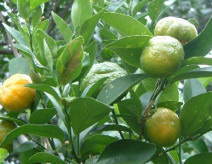This article needs additional citations for verification. (December 2009) |
| Citrus depressa | |
|---|---|

| |
| Shiikwāsā on a tree | |
| Scientific classification | |
| Kingdom: | Plantae |
| Clade: | Tracheophytes |
| Clade: | Angiosperms |
| Clade: | Eudicots |
| Clade: | Rosids |
| Order: | Sapindales |
| Family: | Rutaceae |
| Genus: | Citrus |
| Species: | C. depressa
|
| Binomial name | |
| Citrus depressa | |
Citrus depressa (Citrus × depressa, formerly C. pectinifera, Okinawan: シークヮーサー/シークァーサー, romanized: shiikwaasa, Japanese: ヒラミレモン, romanized: hirami remon or シークヮーサー, shiikwāsā, in English sometimes called shiikuwasha, shequasar, Taiwan tangerine, Okinawa lime,[1] flat lemon, hirami lemon, or thin-skinned flat lemon,[citation needed] is a small citrus fruit often harvested and used when green, rich in flavonoids and native to East Asia (Taiwan and Okinawa Islands, Japan).
Very sour, it is often used like lemon or lime to garnish dishes, but is also used to make jams, or a yellow juice, which can be thinned or sweetened.
Its name is occasionally translated into English as calamansi (calamondin), but strictly speaking, this is a different fruit.
Shiikwaasa is primarily produced in southwest Japan, in the northern region of the main Okinawa island, along with another indigenous Japanese citrus, Tachibana (Citrus tachibana). The two are not the only species of citrus currently growing on the island, as there have been foreign species introduced and have since been crossbred alongside Citrus depressa. Despite the varying diversity of citrus currently found in the region, only Shiikwasa and Tachibana are native to this region, originating in the Ryukyu Islands.[2]
- ^ "Shikwasa Limes". specialtyproduce.com. Retrieved 2020-11-05.
- ^ Yamamoto, Masashi; Takakura, Akiko; Tanabe, Aika; Teramoto, Sayuri; Kita, Masayuki (2017). "Diversity of Citrus depressa Hayata (Shiikuwasha) revealed by DNA analysis". Genetic Resources and Crop Evolution. 64 (4): 805–814. doi:10.1007/s10722-016-0403-2. S2CID 35979614.